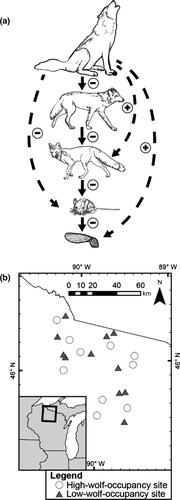当前位置:
X-MOL 学术
›
Ecol. Evol.
›
论文详情
Our official English website, www.x-mol.net, welcomes your feedback! (Note: you will need to create a separate account there.)
Large-scale patterns of seed removal by small mammals differ between areas of low- versus high-wolf occupancy.
Ecology and Evolution ( IF 2.6 ) Pub Date : 2020-06-01 , DOI: 10.1002/ece3.6415 Jennifer L Chandler 1 , Timothy R Van Deelen 2 , Nathan P Nibbelink 3 , John L Orrock 1
Ecology and Evolution ( IF 2.6 ) Pub Date : 2020-06-01 , DOI: 10.1002/ece3.6415 Jennifer L Chandler 1 , Timothy R Van Deelen 2 , Nathan P Nibbelink 3 , John L Orrock 1
Affiliation

|
Because most tree species recruit from seeds, seed predation by small‐mammal granivores may be important for determining plant distribution and regeneration in forests. Despite the importance of seed predation, large‐scale patterns of small‐mammal granivory are often highly variable and thus difficult to predict. We hypothesize distributions of apex predators can create large‐scale variation in the distribution and abundance of mesopredators that consume small mammals, creating predictable areas of high and low granivory. For example, because gray wolf (Canis lupus ) territories are characterized by relatively less use by coyotes (C. latrans ) and greater use by foxes (Vulpes vulpes , Urocyon cinereoargentus ) that consume a greater proportion of small mammals, wolf territories may be areas of reduced small‐mammal granivory. Using large‐scale, multiyear field trials at 22 sites with high‐ and low‐wolf occupancy in northern Wisconsin, we evaluated whether removal of seeds of four tree species was lower in wolf territories. Consistent with the hypothesized consequences of wolf occupancy, seed removal of three species was more than 25% lower in high‐wolf‐occupancy areas across 2 years and small‐mammal abundance was more than 40% lower in high‐wolf areas during one of two study years. These significant results, in conjunction with evidence of seed consumption in situ and the absence of significant habitat differences between high‐ and low‐wolf areas, suggest that top‐down effects of wolves on small‐mammal granivory and seed survival may occur. Understanding how interactions among carnivores create spatial patterns in interactions among lower trophic levels may allow for more accurate predictions of large‐scale patterns in seed survival and forest composition.
中文翻译:

在低和高狼居住区之间,小型哺乳动物去除种子的大规模模式有所不同。
由于大多数树种都是从种子中募集的,因此小哺乳动物食肉动物的种子捕食对于确定森林中植物的分布和再生可能很重要。尽管捕食种子很重要,但小哺乳动物食肉类的大型模式通常变化很大,因此很难预测。我们假设先头食肉动物的分布会在消耗小型哺乳动物的中食动物的分布和数量上造成大规模的变化,从而形成可预测的高和低食肉动物区域。例如,由于灰狼(Canis lupus)领土的特点是土狼(C. latrans)的使用相对较少,而狐狸(Vulpes vulpes,Urocyon cinereoargentus)的使用相对较少。)消耗了更多的小型哺乳动物,狼的领地可能是小型哺乳动物食肉动物减少的地区。通过在威斯康星州北部的22个高低狼居住地点进行的大规模,多年的田间试验,我们评估了在狼区中除去4种树种的种子是否较低。与狼占的假设后果一致,在过去的两年中,高狼占地中三种物种的种子去除率降低了25%以上,而高狼区中的两种在其中一种中,小哺乳动物的丰度降低了40%以上学习年。这些重要的结果,再加上就地食用种子的证据,以及高低狼地区之间没有明显的生境差异,表明狼可能对小哺乳动物的食肉和种子生存产生自上而下的影响。
更新日期:2020-07-30
中文翻译:

在低和高狼居住区之间,小型哺乳动物去除种子的大规模模式有所不同。
由于大多数树种都是从种子中募集的,因此小哺乳动物食肉动物的种子捕食对于确定森林中植物的分布和再生可能很重要。尽管捕食种子很重要,但小哺乳动物食肉类的大型模式通常变化很大,因此很难预测。我们假设先头食肉动物的分布会在消耗小型哺乳动物的中食动物的分布和数量上造成大规模的变化,从而形成可预测的高和低食肉动物区域。例如,由于灰狼(Canis lupus)领土的特点是土狼(C. latrans)的使用相对较少,而狐狸(Vulpes vulpes,Urocyon cinereoargentus)的使用相对较少。)消耗了更多的小型哺乳动物,狼的领地可能是小型哺乳动物食肉动物减少的地区。通过在威斯康星州北部的22个高低狼居住地点进行的大规模,多年的田间试验,我们评估了在狼区中除去4种树种的种子是否较低。与狼占的假设后果一致,在过去的两年中,高狼占地中三种物种的种子去除率降低了25%以上,而高狼区中的两种在其中一种中,小哺乳动物的丰度降低了40%以上学习年。这些重要的结果,再加上就地食用种子的证据,以及高低狼地区之间没有明显的生境差异,表明狼可能对小哺乳动物的食肉和种子生存产生自上而下的影响。



























 京公网安备 11010802027423号
京公网安备 11010802027423号